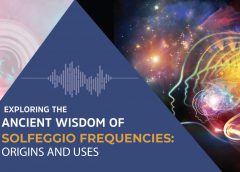Amidst the rapid pace of today’s world, the quest for tranquility, healing, and spiritual development has led many to revisit age-old practices and traditions. One such compelling tradition that has seen a resurgence of interest in recent times is the application of Solfeggio frequencies.
These frequencies, believed to possess significant healing and transformative properties, have roots dating back to antiquity. This article aims to provide an in-depth exploration of the origins and applications of Solfeggio frequencies, their captivating history, and the potential benefits they may offer.
The Genesis of Solfeggio Frequencies
The inception of Solfeggio frequencies can be traced back to the ancient Gregorian chants. In the 11th century, a Benedictine monk named Guido d’Arezzo introduced a musical scale known as the “hexachord,” comprising six notes.Â
The notes, also referred to as solmization syllables, were Ut, Re, Mi, Fa, Sol, and La. These names later evolved into the more recognized Do, Re, Mi, Fa, Sol, and La used in contemporary music. In the 16th century, the Benedictine monk Guido Monaco added the seventh note, “Si,” completing the octave as we understand it today.
The Solfeggio scale, derived from these ancient chants, became a crucial instrument in the instruction and comprehension of music.
The Renaissance of Solfeggio Frequencies
Despite the Solfeggio scale’s continued importance in music theory, its potential healing properties weren’t rediscovered until the late 20th century. In the 1970s, Dr. Joseph Puleo, a naturopathic physician, and Dr. Leonard Horowitz, a researcher, chanced upon an ancient manuscript detailing Solfeggio frequencies and their healing effects.
This discovery ignited interest in investigating the mystical and spiritual facets of these frequencies. According to Dr. Puleo and Dr. Horowitz’s findings, the Solfeggio frequencies corresponded with a set of six tones, each associated with specific physical, emotional, or spiritual attributes.
These frequencies were purported to resonate with the body’s energy centers, known as chakras, thereby promoting healing and equilibrium.
The Six Solfeggio Frequencies and Their Purported Benefits
1. 174 Hz – Foundation and Security: This frequency is purported to aid in establishing a robust foundation and sense of security. It is linked with physical and emotional healing, pain reduction, and fostering a sense of safety.
2. 285 Hz – Transformation and Miracles: The 285 Hz frequency is believed to stimulate the body’s innate ability to transform and heal. It is often linked with facilitating positive change and manifesting miracles in life.
3. 396 Hz – Liberating Guilt and Fear: This frequency is thought to assist in releasing guilt and fear. It is believed to aid in freeing oneself from past traumas and negative thought patterns, fostering a sense of inner peace.
4. 417 Hz – Facilitating Change: The 417 Hz frequency is believed to break negative patterns and facilitate positive change. It is thought to eliminate negative influences and promote personal growth and transformation.
5. 528 Hz – DNA Repair and Transformation: Often referred to as the “love frequency,” 528 Hz is thought to be a potent healer, fostering harmony and balance. It is linked with DNA repair and transformation, as well as facilitating deep spiritual connections.
6. 639 Hz – Enhancing Relationships: This frequency is thought to nurture harmonious relationships and enhance communication. It is linked with healing fractured relationships and fostering feelings of love and understanding.
The Applications of Solfeggio Frequencies
The applications of Solfeggio frequencies are diverse, spanning from sound healing therapies to meditation practices and beyond. Here are a few common ways these frequencies are employed:
1. Sound Healing: Sound healing is a comprehensive practice that utilizes vibrations, such as Solfeggio frequencies, to promote healing, elevation of the chakras by using it and relaxation. Practitioners employ various instruments like singing bowls, tuning forks, or recorded music to introduce these frequencies into the body.
2. Meditation and Mindfulness: Incorporating Solfeggio frequencies into meditation practices is believed to enrich the meditative experience and enhance spiritual connections. The calming effect of these frequencies can assist individuals in achieving a state of mindfulness and inner peace.
3. Chakra Balancing: According to traditional Eastern practices, each chakra in the body corresponds with specific frequencies. Using Solfeggio frequencies during chakra balancing sessions is thought to encourage energy flow and overall well-being.
4. Music Therapy: Music therapists may integrate Solfeggio frequencies into their sessions to support clients dealing with emotional or physical challenges. The calming and healing effects of these frequencies can complement traditional therapy approaches.
5. Personal Development: Some individuals employ Solfeggio frequencies as part of their personal development journey. Listening to these frequencies during introspective moments may assist in overcoming emotional obstacles, enhancing creativity, and fostering a positive outlook on life.
Whether you are seeking relaxation, healing, or spiritual growth, exploring the world of Solfeggio frequencies could be the key to unlocking new dimensions of inner harmony and well-being. Approach these practices with an open mind and a willingness to explore the profound mysteries of sound and its impact on our lives.
Conclusion
The age-old wisdom of Solfeggio frequencies continues to captivate and inspire individuals in the contemporary world. While scientific research on the healing properties of these frequencies is limited, many individuals report positive experiences and transformative effects from their use.

Leave a Reply
You must be logged in to post a comment.